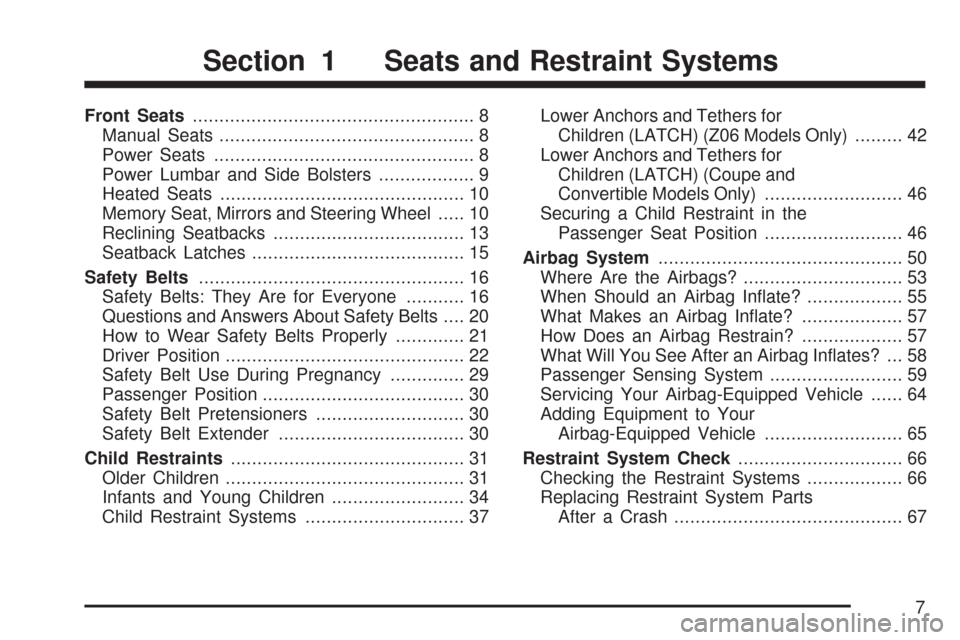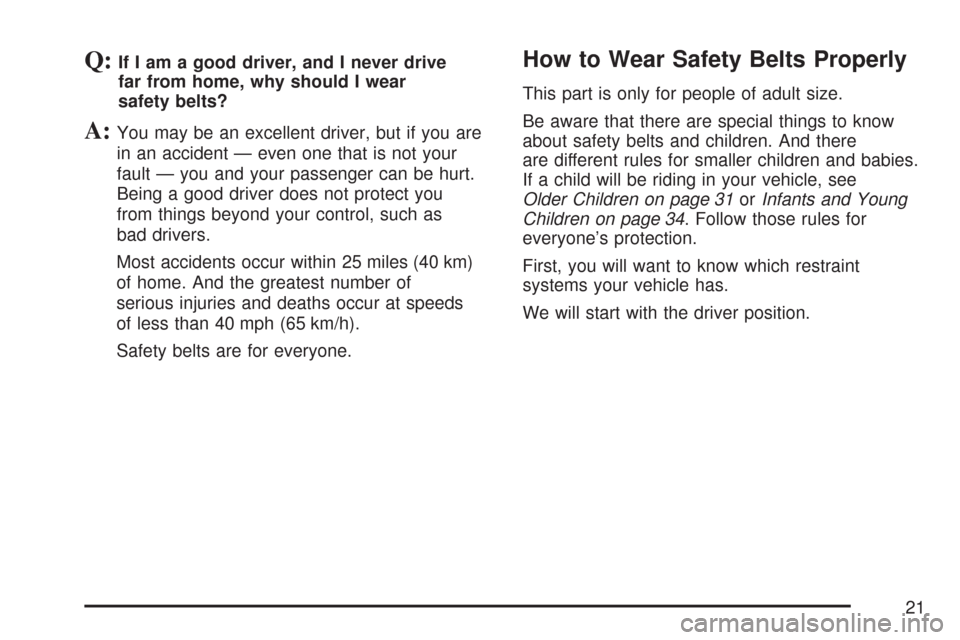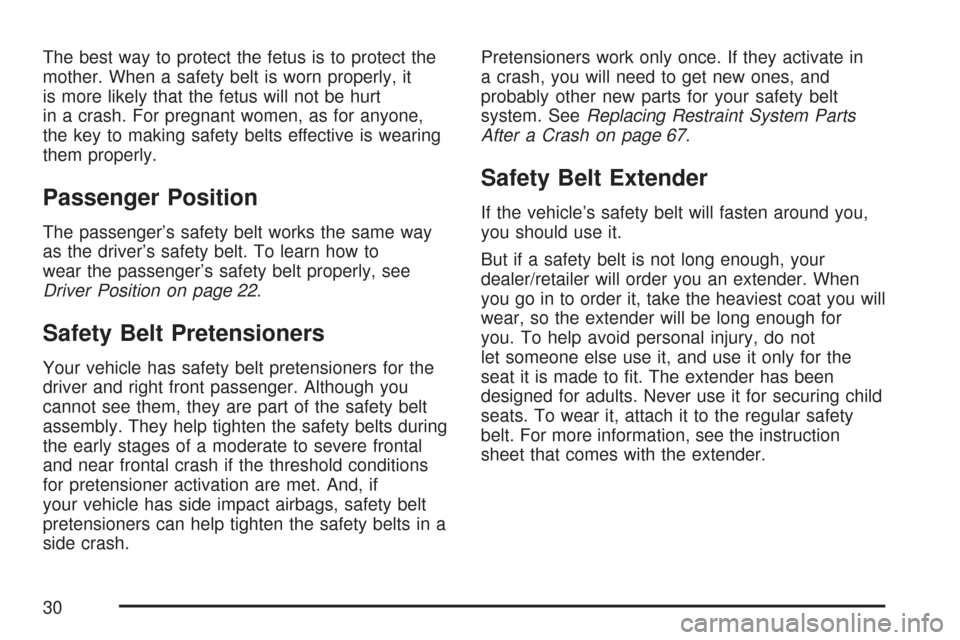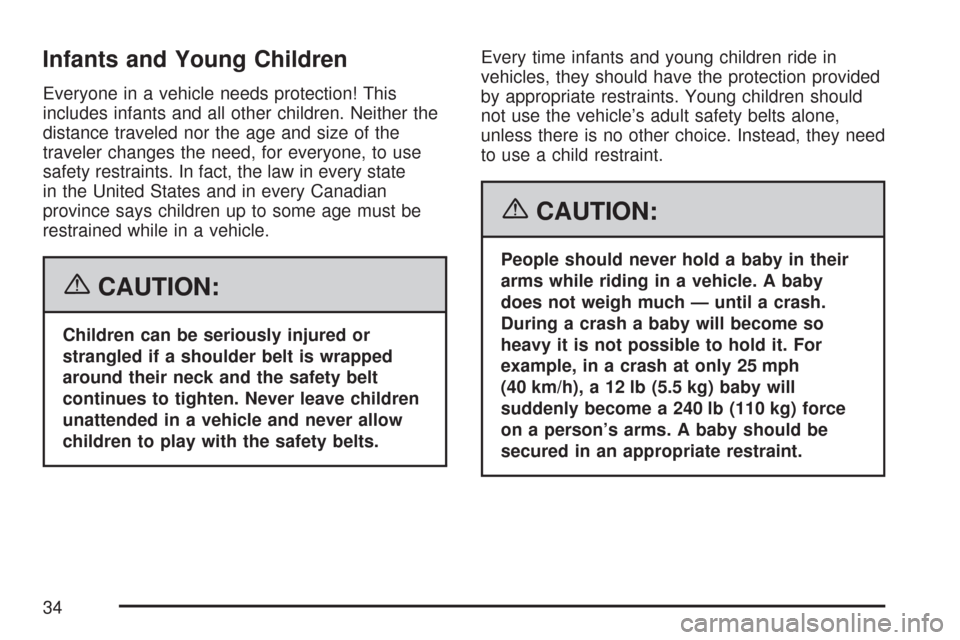Page 1 of 488

Seats and Restraint Systems
........................ 7
Front Seats
.............................................. 8
Safety Belts
............................................ 16
Child Restraints
...................................... 31
Airbag System
........................................ 50
Restraint System Check
......................... 66
Features and Controls
................................. 69
Keys
....................................................... 71
Doors and Locks
.................................... 78
Windows
................................................ 85
Theft-Deterrent Systems
......................... 87
Starting and Operating Your Vehicle
....... 89
Mirrors
.................................................. 108
OnStar
®System
................................... 114
Universal Home Remote System
.......... 118
Storage Areas
...................................... 130
Roof Panel
........................................... 134
Convertible Top
.................................... 139Instrument Panel
........................................ 153
Instrument Panel Overview
................... 156
Climate Controls
................................... 179
Warning Lights, Gages, and Indicators
... 188
Driver Information Center (DIC)
............ 207
Audio System(s)
................................... 244
Driving Your Vehicle
.................................. 273
Your Driving, the Road, and
Your Vehicle
...................................... 274
Towing
................................................. 315
Service and Appearance Care
................... 317
Service
................................................. 319
Fuel
...................................................... 321
Checking Things Under the Hood
......... 328
Rear Axle
............................................. 370
Bulb Replacement
................................ 371
Windshield Replacement
....................... 375
Windshield Wiper Blade Replacement
... 375
2007 Chevrolet Corvette Owner ManualM
1
Page 7 of 488

Front Seats..................................................... 8
Manual Seats................................................ 8
Power Seats................................................. 8
Power Lumbar and Side Bolsters.................. 9
Heated Seats.............................................. 10
Memory Seat, Mirrors and Steering Wheel..... 10
Reclining Seatbacks.................................... 13
Seatback Latches........................................ 15
Safety Belts.................................................. 16
Safety Belts: They Are for Everyone........... 16
Questions and Answers About Safety Belts.... 20
How to Wear Safety Belts Properly............. 21
Driver Position............................................. 22
Safety Belt Use During Pregnancy.............. 29
Passenger Position...................................... 30
Safety Belt Pretensioners............................ 30
Safety Belt Extender................................... 30
Child Restraints............................................ 31
Older Children............................................. 31
Infants and Young Children......................... 34
Child Restraint Systems.............................. 37Lower Anchors and Tethers for
Children (LATCH) (Z06 Models Only)......... 42
Lower Anchors and Tethers for
Children (LATCH) (Coupe and
Convertible Models Only).......................... 46
Securing a Child Restraint in the
Passenger Seat Position.......................... 46
Airbag System.............................................. 50
Where Are the Airbags?.............................. 53
When Should an Airbag In�ate?.................. 55
What Makes an Airbag In�ate?................... 57
How Does an Airbag Restrain?................... 57
What Will You See After an Airbag In�ates? ... 58
Passenger Sensing System......................... 59
Servicing Your Airbag-Equipped Vehicle...... 64
Adding Equipment to Your
Airbag-Equipped Vehicle.......................... 65
Restraint System Check............................... 66
Checking the Restraint Systems.................. 66
Replacing Restraint System Parts
After a Crash........................................... 67
Section 1 Seats and Restraint Systems
7
Page 21 of 488

Q:If I am a good driver, and I never drive
far from home, why should I wear
safety belts?
A:You may be an excellent driver, but if you are
in an accident — even one that is not your
fault — you and your passenger can be hurt.
Being a good driver does not protect you
from things beyond your control, such as
bad drivers.
Most accidents occur within 25 miles (40 km)
of home. And the greatest number of
serious injuries and deaths occur at speeds
of less than 40 mph (65 km/h).
Safety belts are for everyone.
How to Wear Safety Belts Properly
This part is only for people of adult size.
Be aware that there are special things to know
about safety belts and children. And there
are different rules for smaller children and babies.
If a child will be riding in your vehicle, see
Older Children on page 31orInfants and Young
Children on page 34. Follow those rules for
everyone’s protection.
First, you will want to know which restraint
systems your vehicle has.
We will start with the driver position.
21
Page 30 of 488

The best way to protect the fetus is to protect the
mother. When a safety belt is worn properly, it
is more likely that the fetus will not be hurt
in a crash. For pregnant women, as for anyone,
the key to making safety belts effective is wearing
them properly.
Passenger Position
The passenger’s safety belt works the same way
as the driver’s safety belt. To learn how to
wear the passenger’s safety belt properly, see
Driver Position on page 22.
Safety Belt Pretensioners
Your vehicle has safety belt pretensioners for the
driver and right front passenger. Although you
cannot see them, they are part of the safety belt
assembly. They help tighten the safety belts during
the early stages of a moderate to severe frontal
and near frontal crash if the threshold conditions
for pretensioner activation are met. And, if
your vehicle has side impact airbags, safety belt
pretensioners can help tighten the safety belts in a
side crash.Pretensioners work only once. If they activate in
a crash, you will need to get new ones, and
probably other new parts for your safety belt
system. SeeReplacing Restraint System Parts
After a Crash on page 67.
Safety Belt Extender
If the vehicle’s safety belt will fasten around you,
you should use it.
But if a safety belt is not long enough, your
dealer/retailer will order you an extender. When
you go in to order it, take the heaviest coat you will
wear, so the extender will be long enough for
you. To help avoid personal injury, do not
let someone else use it, and use it only for the
seat it is made to �t. The extender has been
designed for adults. Never use it for securing child
seats. To wear it, attach it to the regular safety
belt. For more information, see the instruction
sheet that comes with the extender.
30
Page 31 of 488
Child Restraints
Older Children
Older children who have outgrown booster seats
should wear the vehicle’s safety belts.
Q:What is the proper way to wear
safety belts?
A:An older child should wear a lap-shoulder belt
and get the additional restraint a shoulder belt
can provide. The shoulder belt should not
cross the face or neck. The lap belt should �t
snugly below the hips, just touching the
top of the thighs. It should never be worn over
the abdomen, which could cause severe or
even fatal internal injuries in a crash.
According to accident statistics, children are safer
when properly restrained in the rear seating
positions than in the front seating positions.
In a crash, children who are not buckled up can
strike other people who are buckled up, or can be
thrown out of the vehicle. Older children need
to use safety belts properly.
31
Page 32 of 488
{CAUTION:
Never do this.
Here two children are wearing the same
belt. The belt cannot properly spread the
impact forces. In a crash, the two children
can be crushed together and seriously
injured. A belt must be used by only one
person at a time.
Q:What if a child is wearing a lap-shoulder
belt, but the child is so small that the
shoulder belt is very close to the child’s
face or neck?
A:Move the child toward the center of the
vehicle, but be sure that the shoulder belt still
is on the child’s shoulder, so that in a crash
the child’s upper body would have the restraint
that belts provide.
32
Page 34 of 488

Infants and Young Children
Everyone in a vehicle needs protection! This
includes infants and all other children. Neither the
distance traveled nor the age and size of the
traveler changes the need, for everyone, to use
safety restraints. In fact, the law in every state
in the United States and in every Canadian
province says children up to some age must be
restrained while in a vehicle.
{CAUTION:
Children can be seriously injured or
strangled if a shoulder belt is wrapped
around their neck and the safety belt
continues to tighten. Never leave children
unattended in a vehicle and never allow
children to play with the safety belts.Every time infants and young children ride in
vehicles, they should have the protection provided
by appropriate restraints. Young children should
not use the vehicle’s adult safety belts alone,
unless there is no other choice. Instead, they need
to use a child restraint.
{CAUTION:
People should never hold a baby in their
arms while riding in a vehicle. A baby
does not weigh much — until a crash.
During a crash a baby will become so
heavy it is not possible to hold it. For
example, in a crash at only 25 mph
(40 km/h), a 12 lb (5.5 kg) baby will
suddenly become a 240 lb (110 kg) force
on a person’s arms. A baby should be
secured in an appropriate restraint.
34
Page 35 of 488
{CAUTION:
Children who are up against, or very close
to, any airbag when it in�ates can be
seriously injured or killed. Airbags plus
lap-shoulder belts offer protection for
adults and older children, but not for
young children and infants. Neither the
vehicle’s safety belt system nor its airbag
system is designed for them. Young
children and infants need the protection
that a child restraint system can provide.
35